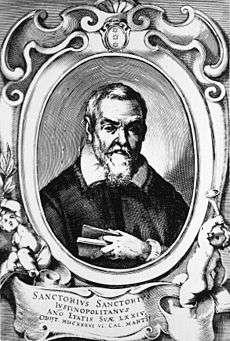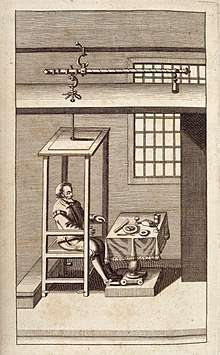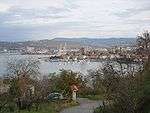Santorio Santorio
| Santorio Santorio | |
|---|---|
 | |
| Born |
March 29, 1561 Capodistria, Republic of Venice |
| Died |
February 22, 1636 (aged 74) Venice |
| Alma mater | University of Padua |
| Known for | Discoveries concerning metabolism and invention of technical instruments |
Santorio Santorio (29 March 1561 – 22 February 1636),[1] also called Sanctorio Sanctorio, Santorio Santorii, Sanctorius of Padua, Sanctorio Sanctorius[2] and various combinations of these names, was a Venetian physiologist, physician, and professor, who introduced the quantitative approach into medicine. He is also known as the inventor of several medical devices, including the thermometer. His work De Statica Medicina, written in 1614, saw many publications and influenced generations of physicians.[3][4]
Life
Santorio's mother was a noblewoman from the Mediterranean coastal town of Capodistria (today Koper, southwestern Slovenia, then part of the Republic of Venice), which is where she gave birth to him.[5] Santorio's father was a nobleman from Friuli working for the Venetian republic.
He was educated in his home town, then entered the University of Padua, from which he obtained his medical degree in 1582.[5]
Work
Santorio worked as the personal physician to a nobleman from 1587 to 1599, at which point he set up a medical practice in Venice.
From 1611 to 1624, Santorio was the chair of theoretical medicine at the University of Padua where he performed experiments in temperature, respiration and weight.
His practices and thinking followed Hippocratic and Galenic principles, but he was a keen experimentalist.[5]
Inventions
Santorio was the first to use a wind gauge, a water current meter, the pulsilogium (a device used to measure the pulse rate), and a thermoscope.[6] Whereas he invented the former two devices, it is unclear exactly who invented the latter two; it could be his friend Galileo Galilei or another person of the learned circle in Venice of which they were members.[7]

He also invented a device which he called the "trocar" (not identical to the modern trocar) for removing bladder stones.[8]
Santorio introduced the thermoscope in the work titled Sanctorii Sanctorii Commentaria in Artem medicinalem Galeni in 1612.[9]
The pulsilogium was probably the first machine of precision in medical history.Extensive experimentation with his new tool allowed Santorio to derive the circadian rhythm (24 hour cycle) of the cardiac frequency. A century later another physician, de Lacroix, used the pulsilogium to test cardiac function.[10]
Study of metabolism
Sanctorius studied the so-called perspiratio insensibilis or insensible perspiration of the body, already known to Galen and other ancient physicians, and originated the study of metabolism.[11] For a period of thirty years Santorio use a chair-device to weigh himself and everything he ate and drank, as well as his urine and feces. He compared the weight of what he had eaten to that of his waste products, the latter being considerably smaller because for every eight pounds of food he ate, he excreted only 3 pounds of waste. Santorio also applied his weighing device to study his patients, but records of these experiments have been lost.[11]
His notable conclusion on finding this was that:
Insensible Perspiration is either made by the Pores of the Body, which is all over perspirable, and cover’d with a Skin like a Net; or it is performed by Respiration through the Mouth, which usually, in the Space of one Day, amounts to about the Quantity of half a Pound, as may plainly be made appear by breathing upon a Glass.[6]
This important experiment is the origin of the significance of weight measurement in medicine.[12] While his experiments were replicated and augmented by his followers and were finally surpassed by those of Lavoisier in 1790, he is still celebrated as the father of experimental physiology. The "weighing chair", which he constructed and employed during this experiment, is also famous.[10]
Later life
Santorio died in Venice.
References
- ↑ Pintar, Ivan (2009). "Sanctorius Sanctorius". In Vide Ogrin, Petra (electronic ed.). Cankar, Izidor et al. (printed ed.). Slovenski biografski leksikon (in Slovenian). ISBN 978-961-268-001-5. Check date values in:
|year= / |date= mismatch(help) - ↑ Pearce, J.M.S. "A Brief History of the Clinical Thermometer". Oxford University Press. Retrieved 17 July 2016.
- ↑ "SANTORIO, Santorio (1561–1636): Medicina Statica: Being the Aphorisms of Sanctorius..." Hagströmerbiblioteket. Retrieved 22 December 2017.
- ↑ Zupanič Slavec, Zvonka (2001). "Vpliv Santorijevih del na Dubrovčana Đura Armena Baglivija" [The Influence of Santorio Santorii on Đuro Armen Baglivi from Dubrovnik] (PDF). Medicinski razgledi (in Slovenian and English). 40 (4): 443–450.
- 1 2 3 Van Helden, Al (1995). "Santorio Santorio". The Galileo Project. Retrieved 2017-12-22.
- 1 2 "Santorio Santorio (1561-1636): Medicina statica". Vaulted Treasures. University of Virginia, Claude Moore Health Sciences Library.
- ↑ Van Helden, Albert. "Galileo Project" (PDF). Rice University. pp. 28–29. Retrieved 18 June 2015.
- ↑ Daniel Boorsten, The Discoverers, Chap. 49
- ↑ Kelly, Kate (2010). "Santorio and the Body as a Machine". The Scientific Revolution and Medicine: 1450-1700. Infobase Publishing. ISBN 9781438126364.
- 1 2 Measure of the Heart: Santorio Santorio and the Pulsilogium, Richard de Grijs, Daniel Vuillermin, arXiv.org, arXiv:1702.05211v1 [physics.hist-ph], 17 February 2017, accessed 2017-02-28
- 1 2 Eknoyan, G. (1999). "Santorio Sanctorius (1561-1636) - founding father of metabolic balance studies". American Journal of Nephrology. 19 (2): 226–233. doi:10.1159/000013455. ISSN 0250-8095. PMID 10213823.
- ↑ Kuriyama, Shigehisa. "The Forgotten Fear of Excrement." Journal of Medieval and Early Modern Studies. (2008): n. page. Print.
External links
| Wikimedia Commons has media related to Santorio Santorio. |
- Works by Santorio Santorio at Open Library
- A project on Santorio Santorio and the Emergence of Quantifying Procedures in Medicine is currently hosted by the Centre for Medical History of the University of Exeter (UK)
- An introductory video on Santorio's life and works here

